Con piacere segnalo il mio prossimo appuntamento didattico:
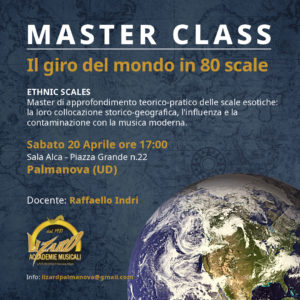
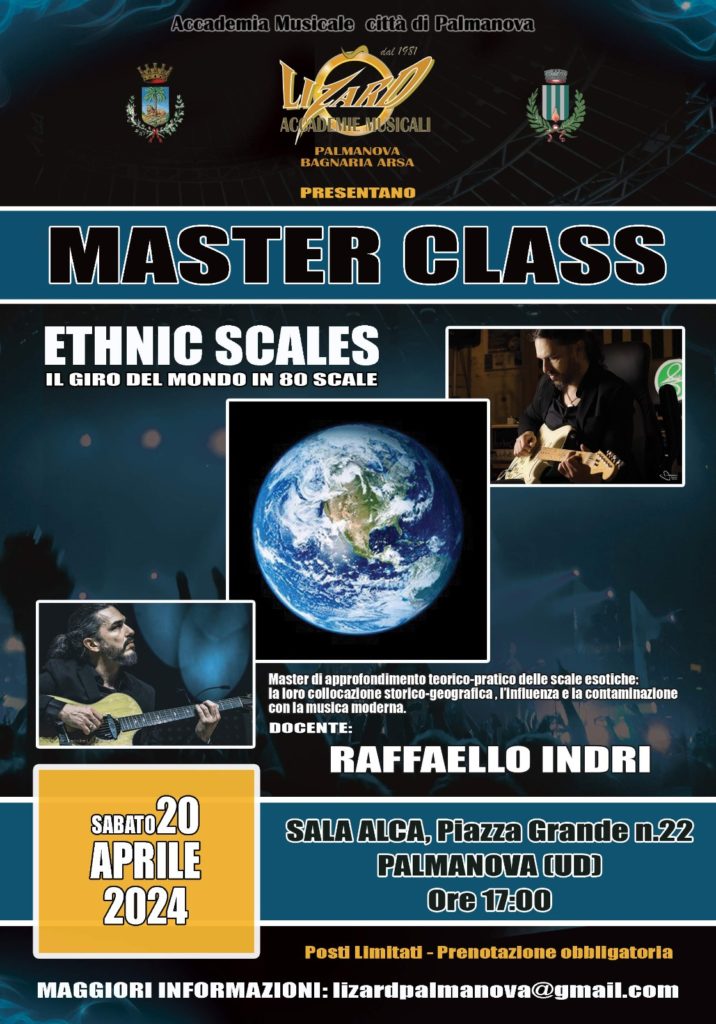
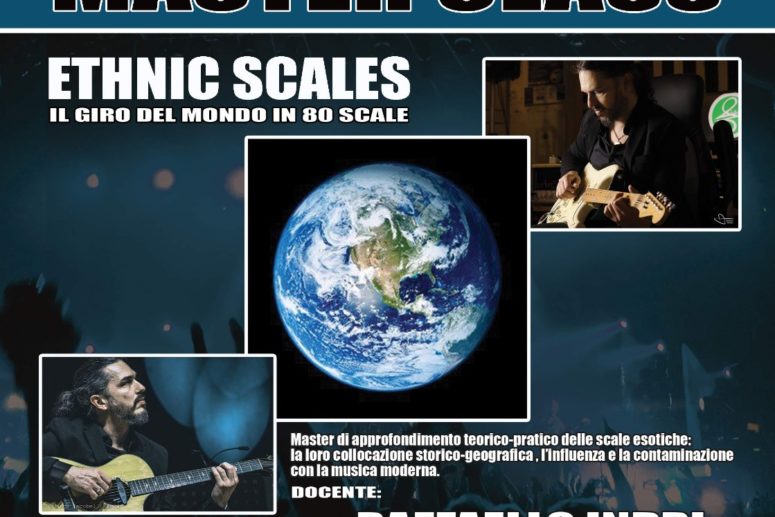
Con piacere segnalo il mio prossimo appuntamento didattico:



WARM UP FROM THE CRYPT #12 – Slide legato
Con questo dodicesimo warm up, si conclude la prima parte video dei 24 esercizi per il riscaldamento presenti nel libro “Guitar tricks from the crypt”.
Ricordo che questi studi hanno l’obiettivo di stimolare la prontezza sullo strumento attraverso un atteggiamento attento e mirato alla pratica di una tecnica alla volta. Il consiglio, una volta memorizzati i warm up, è di eseguirli quotidianamente per 20 minuti, senza prevedere più di 4 ripetizioni per ognuno, a velocità progressiva, fino a quella limite in cui la performance risulta pulita e a tempo.
Nel warm up di oggi, ho preso in esame l’atteggiamento dello “slide”, ovvero quella particolare situazione di legatura di portamento in cui eseguiamo le note utilizzando uno stesso dito che rimane ancorato alla tastiera e che si muove in senso orizzontale, scivolando tra i tasti senza interrompere la vibrazione della corda.
Il mondo dello slide-legato offre infinite possibilità creative ed espressive per i chitarristi di tutti i livelli.
Tra i grandi utilizzatori di questa tecnica, troviamo senz’altro Steve Vai, il quale ha arricchito il suo vocabolario con tantissimi esempi di utilizzo.
Ma il brano che mi ha ispirato per comporre questo studio è senz’altro “Waves” del funambolico Guthrie Govan.
L’ascolto suggerito per questo dodicesimo incontro, quindi, è proprio il disco solista “Erotic Cakes” di Guthrie Govan del 2006, da cui è tratto il brano “Waves”.Spero che questa serie di warm up sia stata utile per la vostra crescita personale, altri studi, come già accennato, sono disponibili nel libro “Guitar Tricks From the Crypt”, che presto sarà ristampato e reso disponibile nello store del sito.
Se avete piacere, mandatemi un feedback riguardo ai risultati raggiunti; vi auguro buono studio e vi mando un saluto dalla cripta… a presto per nuove scorribande chitarristiche.
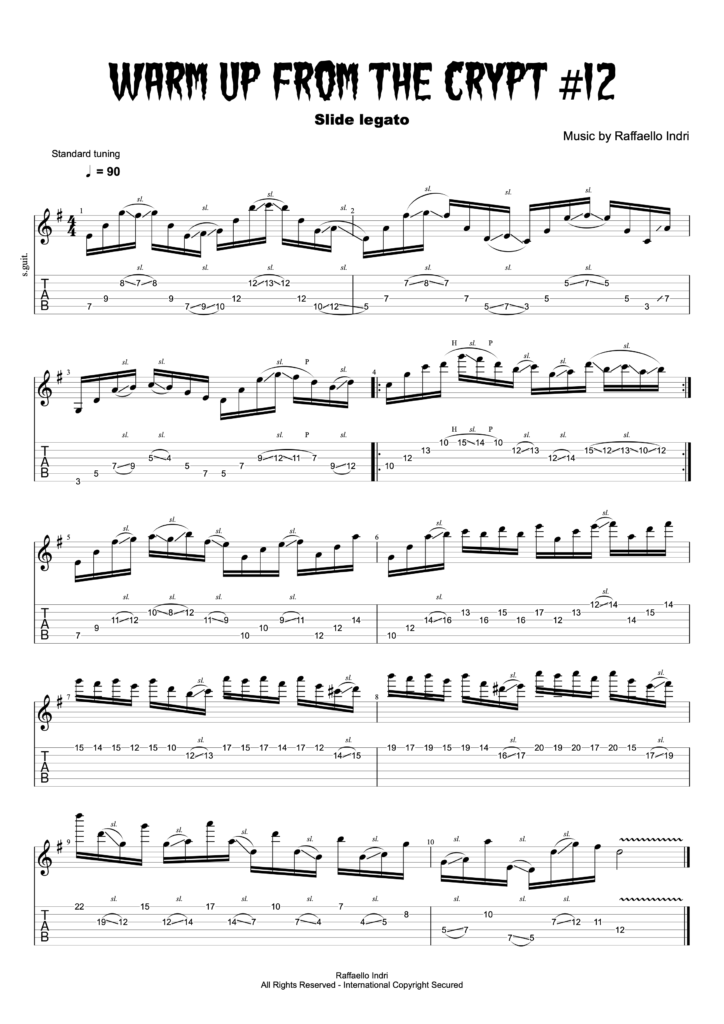
ENG
With this twelfth warm-up, the first video part of the 24 warm-up exercises from the book “Guitar Tricks from the Crypt” comes to a close.
I would like to remind you that the purpose of these studies is to enhance readiness on the instrument through a focused and attentive approach to practicing one technique at a time.
Once the warm-ups are memorized, it is advisable to perform them daily for 20 minutes, not exceeding 4 repetitions each, gradually increasing speed until reaching the limit where the performance is clean and in time.
In today’s warm-up, I focused on the technique of “slide,” which is the particular situation of legato articulation where we execute notes using the same finger anchored to the fretboard, moving horizontally, sliding between frets without interrupting the string’s vibration.
The world of slide legato offers endless creative and expressive possibilities for guitarists of all levels.
Among the great users of this technique is certainly Steve Vai, who has enriched his vocabulary with many examples of its use. However, the piece that inspired me to compose this study is undoubtedly “Waves” by the virtuosic Guthrie Govan.
Therefore, the suggested listening for this twelfth session is Guthrie Govan’s solo album “Erotic Cakes” from 2006, from which the track “Waves” is taken.
I hope this series of warm-ups has been helpful for your personal growth.
Additional studies, as mentioned earlier, are available in the book “Guitar Tricks From the Crypt,” which will soon be reprinted and made available in the website’s store.
If you’d like, please send me feedback regarding the results you’ve achieved.
I wish you happy practicing and send you greetings from the crypt… See you soon for new guitar adventures.
 WARM UP FROM THE CRYPT #11 – Pivoting
WARM UP FROM THE CRYPT #11 – Pivoting
In questo undicesimo warm up, ho voluto concentrare l’attenzione sulla tecnica del “pivoting”.
Si tratta di un approccio musicale in cui una nota pedale viene utilizzata come punto di riferimento fisso, mentre altre note vengono suonate intorno ad essa, creando un effetto armonico interessante.
Spesso questo sviluppo viene utilizzato su corda singola e tenendo come nota pedale una corda a vuoto.
L’idea può però essere estesa allo studio di tutto il materiale melodico, arpeggi e scale, mettendo fissa una qualsiasi nota da cui sono costituiti e gestendo le altre in appoggio, a creare linee melodiche che possono richiamare soluzioni barocche.
Nel warm up in gioco, sono rimasto su un approccio scalare, coinvolgendo più corde e cercando di rendere lo sviluppo melodico funzionale all’ottimizzazione della coordinazione e dell’impostazione delle dita della mano sinistra.
Oltre a dare importanti spunti per il fraseggio, ritengo questo esercizio un ottimo modo per allenare l’indipendenza delle dita e, parallelamente, una buona plettrata alternata.
Anche in questa occasione, si sconfina nelle sonorità neoclassiche, ma gli effettivi benefici si possono raccogliere per qualsiasi contesto musicale.
Tra i chitarristi che nel loro stile spesso utilizzano il “pivoting”, sicuramente c’è da menzionare il re indiscusso della chitarra neoclassica ovvero sua maestà Yngwie Malmsteen.
Un disco che consiglio e a cui sono particolarmente legato è senz’altro “Trilogy” del 1986.
Qui si trova la traccia strumentale “Trilogy Suite Op.5” che senza dubbio ha gettato le basi per la mia passione per la chitarra elettrica, intuendone il suo grande potenziale emotivo-espressivo.
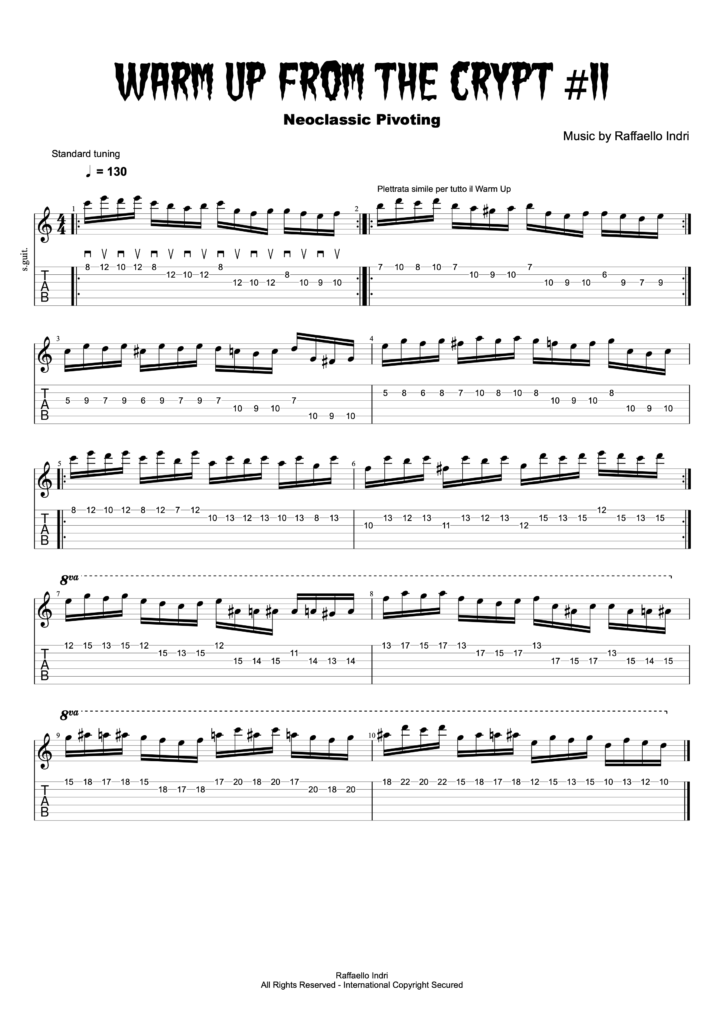
ENG
In this eleventh warm-up, I wanted to focus attention on the technique of “pivoting”.
This is a musical approach where a pedal note is used as a fixed reference point, while other notes are played around it, creating an interesting harmonic effect.
Often, this technique is used on a single string, with an open string serving as the pedal note.
However, the idea can be extended to the study of all melodic material, arpeggios, and scales, by fixing any note they consist of and managing the others in support, creating melodic lines that can evoke Baroque solutions.
In the warm-up at hand, I remained on a scalar approach, involving multiple strings and trying to make the melodic development functional to optimize coordination and finger positioning of the left hand.
In addition to providing important insights for phrasing, I consider this exercise an excellent way to train finger independence and, simultaneously, good alternate picking.
Also on this occasion, we delve into neoclassical sounds, but the actual benefits can be reaped for any musical context.
Among the guitarists who often use “pivoting” in their style, there is certainly the undisputed king of neoclassical guitar, His Majesty Yngwie Malmsteen.
An album that I recommend and to which I am particularly attached is undoubtedly “Trilogy” from 1986. Here you can find the instrumental track “Trilogy Suite Op.5” which undoubtedly laid the foundations for my passion for the electric guitar, sensing its great emotional-expressive potential.

WARM UP FROM THE CRYPT #10 – Tapping
Esercizi di tecnica in loop a velocità progressiva tratti dal libro “Guitar Tricks from the Crypt” Cap. 1
Tra le mie tecniche preferite su cui ho investito molte delle mie ore sulla chitarra, senz’altro c’è il Tapping. Idolo indiscusso e precursore di questo modo di suonare è, senza dubbio, il grandissimo e (purtroppo) compianto Eddie Van Halen. Nel warm up in gioco, ho voluto sintetizzare diversi approcci che prevedono il Tapping nella veste 4 + 1, ovvero considero operative sulla tastiera 4 dita della mano sinistra e un dito della mano destra. Per quello che riguarda il dito della mano destra, io uso il medio, perché ciò mi permette di continuare a tenere tra pollice e indice il plettro. Su quest’ultimo punto, si rimane in un campo di soggettività, dove alcuni chitarristi (tra cui lo stesso Eddie Van Halen) usano invece principalmente l’indice. Più che con altri warm up, questo che vi propongo oggi può risultare particolarmente ostico se non si ha dimestichezza con questa tecnica: vi suggerisco di fare esercizi preliminari più semplici, magari su corda singola, per aumentare progressivamente le difficoltà inserendo i salti di corda, lo studio delle triadi e delle quadriadi, sempre con l’uso del Tapping. Per quello che riguarda lo stile, al solito, sono rimasto su coordinate neoclassiche e, in questa occasione, oltre al già citato Van Halen, un chitarrista che voglio menzionare e che mi entusiasma da sempre nelle sue produzioni e nei suoi virtuosismi è senz’altro Michael Romeo, chitarrista dei Symphony X. Tra tutta la produzione, il disco d’obbligo da ascoltare è sicuramente “The Divine Wings of Tragedy” del 1997.
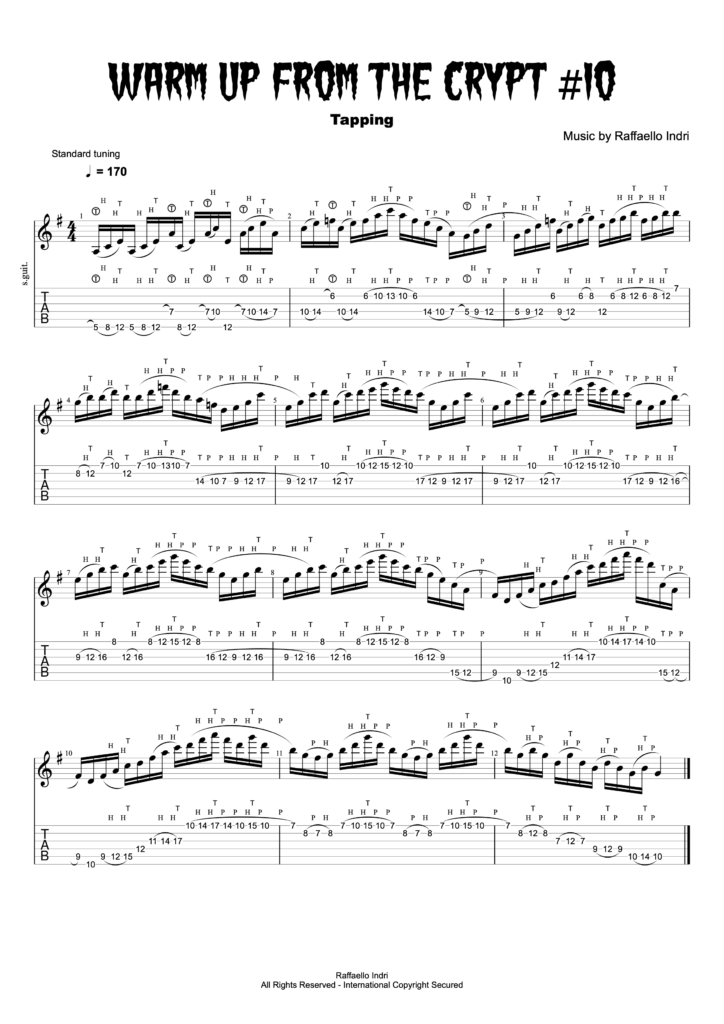
ENG
Among my favorite techniques on which I have invested many hours on the guitar, there is undoubtedly Tapping. The undisputed idol and precursor of this way of playing is, without a doubt, the great and (unfortunately) late Eddie Van Halen. In the warm-up I’m playing, I wanted to synthesize various approaches that involve Tapping in the 4 + 1 configuration, meaning I consider four fingers of the left hand and one finger of the right hand operative on the fretboard. As for the finger of the right hand, I use the middle finger, because it allows me to continue holding the pick between my thumb and index finger. On this last point, it remains a matter of subjectivity, where some guitarists (including Eddie Van Halen himself) instead mainly use the index finger.More than with other warm-ups, this one I propose today can be particularly challenging if you’re not familiar with this technique: I suggest doing simpler preliminary exercises, perhaps on a single string, to gradually increase the difficulty by incorporating string skipping, the study of triads and seventh chords, always using Tapping.Regarding the style, as usual, I’ve stuck to neoclassical coordinates and, on this occasion, in addition to the aforementioned Van Halen, a guitarist I want to mention who has always excited me in his productions and virtuosic performances is undoubtedly Michael Romeo, guitarist of Symphony X. Among all his work, the must-listen album is definitely “The Divine Wings of Tragedy” from 1997.

WARM UP FROM THE CRYPT #9 – Cross picking
Tra le tecniche più ostiche sulla chitarra, un ruolo importante lo gioca il “cross-picking”, ovvero la plettrata alternata su corde consecutive. La difficoltà è legata all’alta coordinazione richiesta per le due mani nel gestire cambi di corda continui. In tanti casi, per sopperire alla complessità nel raggiungere velocità, si usano lo sweep-picking o l’hybrid-picking. A mio avviso, tutte le tecniche sono efficaci ed è fondamentale padroneggiarle con disinvoltura per avere a disposizione un vocabolario ampio di fraseggio e di espressione. Il cross-picking ha il grande vantaggio di dare “peso” e “attacco” a tutte le note e, a velocità ragionevoli, è veramente proficuo. Nel warm up in questione, ho voluto porre attenzione sugli arpeggi con un numero progressivamente crescente di corde coinvolte. Maestro indiscusso di questa tecnica o, almeno, il mio preferito, è senza dubbio Steve Morse. L’ascolto, quindi, consigliato di questa settima è “Coast to Coast” della Steve Morse Band del 1992, non il suo primo disco, ma quello che comprai io per primo e che, tuttora, rimane uno dei miei preferiti.
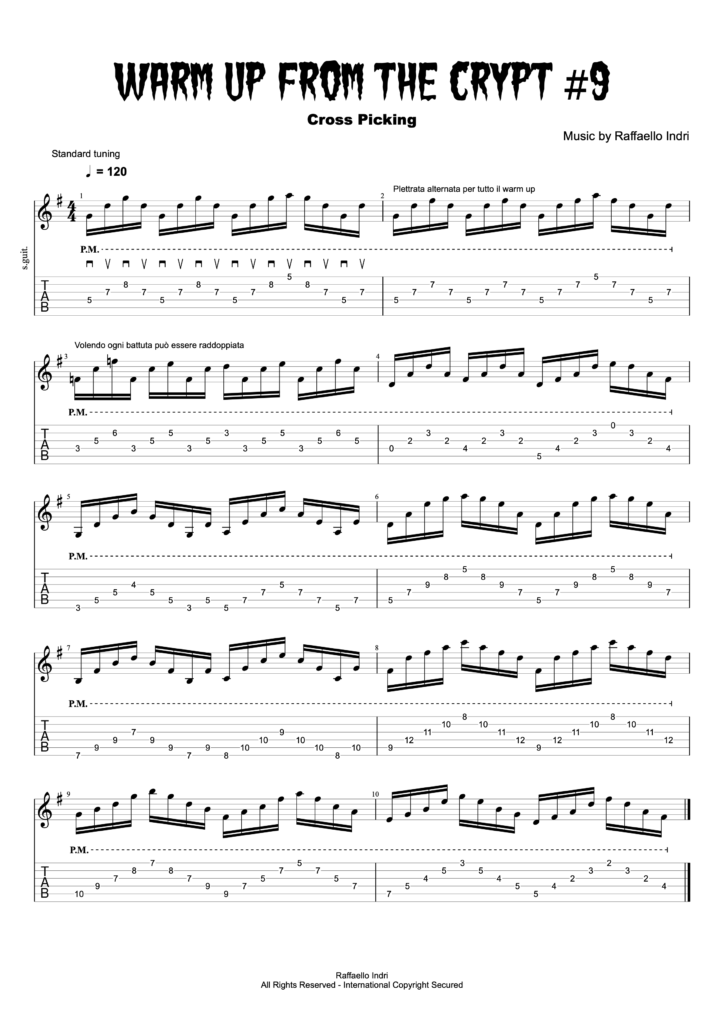
ENG
Among the most challenging techniques on the guitar, an important role is played by “cross-picking,” which involves alternate picking on consecutive strings. The difficulty is linked to the high coordination required for both hands to manage continuous string changes. In many cases, to overcome the complexity of achieving speed, sweep-picking or hybrid-picking techniques are used. In my opinion, all techniques are effective, and it’s essential to master them effortlessly to have a wide vocabulary of phrasing and expression available. Cross-picking has the great advantage of giving “weight” and “attack” to all the notes and, at reasonable speeds, is truly beneficial. In the warm-up in question, I wanted to focus on arpeggios with a progressively increasing number of involved strings. The undisputed master of this technique, or at least my favorite, is undoubtedly Steve Morse. Therefore, the recommended listening for this week is “Coast to Coast” by the Steve Morse Band from 1992, not his first record, but the one I first bought and still remains one of my favorites.

WARM UP FROM THE CRYPT #8 – Seventh Arpeggios
Padroneggiare gli arpeggi è ormai una prerogativa fondamentale per dare interesse al fraseggio. In questo warm up, ho voluto porre attenzione agli arpeggi di settima con un approccio che ho trovato nei fraseggi di Greg Howe. Si tratta di prevedere l’integrazione sia dell’hybrid-picking che del hammer-on-from-nowhere, tecnica menzionata dallo stesso Howe, dove le dita della mano sinistra intervengono sulla tastiera senza prevedere una plettrata, ma appunto “martellando” direttamente il tasto.
Ho cercato di esporre un po’ tutte le tipologie di arpeggio, mettendo sempre in gioco un percorso “circolare” delle diteggiature lungo la tastiera, a favorire uno sviluppo in loop dell’esercizio.
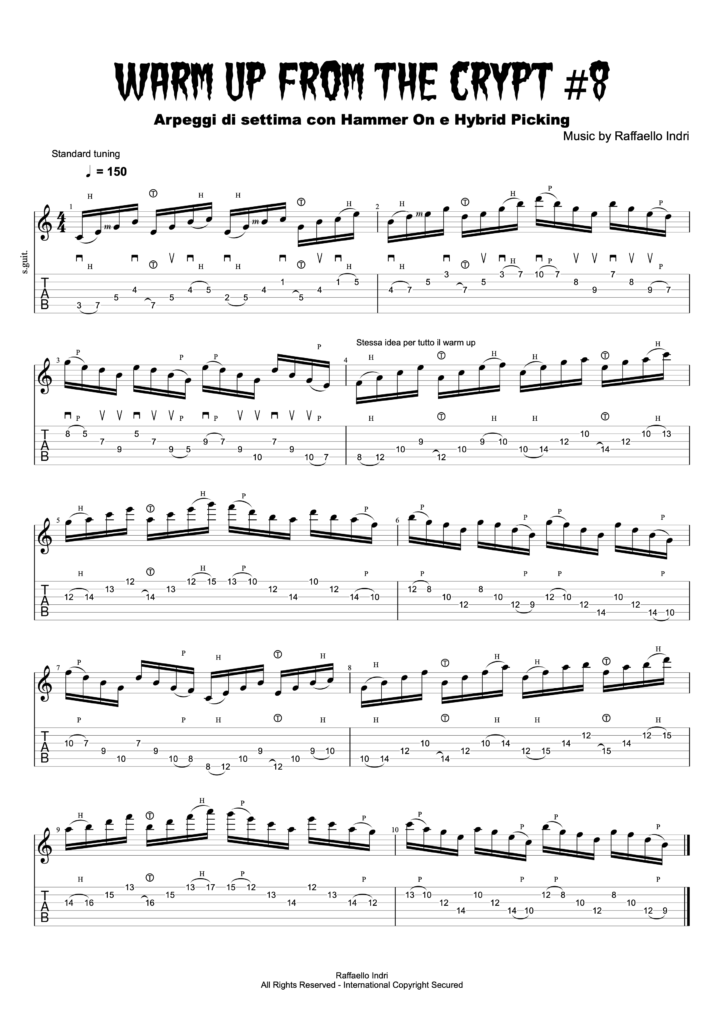
Le applicazioni degli arpeggi sono molteplici e applicabili in tutti gli stili musicali, ma dove ci si diverte di più con il loro utilizzo è probabilmente nel funk-fusion, dove le loro soluzioni gestuali possono aiutare non solo l’interesse melodico del fraseggio, ma anche quello ritmico.
Per l’occasione, riciterei un maestro indiscusso quale Greg Howe e suggerirei l’ascolto di “Introspection” del 1993, disco che avviò una nuova strada per la chitarra solista rock, dove alle scorribande shred si affiancarono ritmi funk e armonie e melodie jazz-fusion.
ENG
Mastering arpeggios has become a fundamental prerequisite for adding interest to phrasing. In this warm-up exercise, I aimed to focus on seventh arpeggios with an approach inspired by the phrasing of Greg Howe. This involves incorporating both hybrid picking and hammer-on-from-nowhere techniques, as mentioned by Howe himself, where the left-hand fingers intervene on the fretboard without a pick stroke, but rather “hammering” directly onto the fret.
I’ve tried to cover various types of arpeggios, always incorporating a “circular” fingering pattern along the fretboard to facilitate a looped development of the exercise.
The applications of arpeggios are manifold and applicable in all musical styles, but where one might find the most enjoyment in their usage is likely in funk-fusion, where their gestural solutions can aid not only in the melodic interest of phrasing but also in rhythmic aspects.
For this occasion, I would recommend acknowledging an undisputed master such as Greg Howe and suggest listening to “Introspection” from 1993, an album that paved a new path for rock solo guitar, where shred escapades were accompanied by funk rhythms and jazz-fusion harmonies and melodies.
Mastering arpeggios has become a fundamental prerequisite for adding interest to phrasing. In this warm-up exercise, I aimed to focus on seventh arpeggios with an approach inspired by the phrasing of Greg Howe. This involves incorporating both hybrid picking and hammer-on-from-nowhere techniques, as mentioned by Howe himself, where the left-hand fingers intervene on the fretboard without a pick stroke, but rather “hammering” directly onto the fret.
I’ve tried to cover various types of arpeggios, always incorporating a “circular” fingering pattern along the fretboard to facilitate a looped development of the exercise.
The applications of arpeggios are manifold and applicable in all musical styles, but where one might find the most enjoyment in their usage is likely in funk-fusion, where their gestural solutions can aid not only in the melodic interest of phrasing but also in rhythmic aspects.
For this occasion, I would recommend acknowledging an undisputed master such as Greg Howe and suggest listening to “Introspection” from 1993, an album that paved a new path for rock solo guitar, where shred escapades were accompanied by funk rhythms and jazz-fusion harmonies and melodies.
Mastering arpeggios has become a fundamental prerequisite for adding interest to phrasing. In this warm-up exercise, I aimed to focus on seventh arpeggios with an approach inspired by the phrasing of Greg Howe. This involves incorporating both hybrid picking and hammer-on-from-nowhere techniques, as mentioned by Howe himself, where the left-hand fingers intervene on the fretboard without a pick stroke, but rather “hammering” directly onto the fret.
I’ve tried to cover various types of arpeggios, always incorporating a “circular” fingering pattern along the fretboard to facilitate a looped development of the exercise.
The applications of arpeggios are manifold and applicable in all musical styles, but where one might find the most enjoyment in their usage is likely in funk-fusion, where their gestural solutions can aid not only in the melodic interest of phrasing but also in rhythmic aspects.
For this occasion, I would recommend acknowledging an undisputed master such as Greg Howe and suggest listening to “Introspection” from 1993, an album that paved a new path for rock solo guitar, where shred escapades were accompanied by funk rhythms and jazz-fusion harmonies and melodies.

WARM UP FROM THE CRYPT #7 – Alternate picking on two-notes-per-string
La plettrata alternata è una tecnica fondamentale per ogni chitarrista e padroneggiarla richiede pratica costante e pazienza. Con questo warm up, ho voluto concentrare l’attenzione sulle situazioni scalari che si sviluppano su due note per corda.
Nello sviluppare l’esercizio, ho cercato di mettere in gioco quante più combinazioni di dita possibili per allenare non solo la coordinazione della plettrata, ma anche la gestione di diteggiature diverse.
Oltre a questo, sottintesa, c’è stata anche la volontà di inserire degli spostamenti di accento, giocando con le somme di figure ritmiche pari. Senza entrare troppo nei dettagli della polimetria, l’idea base è che 4 sedicesimi + 6 sedicesimi generano un ciclo di 10 sedicesimi ovvero 5/8 con conseguente spostamento degli accenti.
Continue fonti di ispirazioni su questo tipo di approccio arrivano dal grandissimo John Mclaughlin: riconosciuto per la sua versatilità e il suo virtuosismo, ha abbracciato una vasta gamma di stili musicali tra cui jazz, fusion, rock e musica indiana. Ha studiato con il leggendario musicista indiano Ravi Shankar, nonché con altri maestri indiani, ed è stato fortemente influenzato dalla musica e dalla filosofia indiana.
L’ascolto consigliato di questa settimana è “A Handful of Beauty”, il primo album della band Shakty del 1976.
Ricordate sempre di praticare con costanza e di divertirvi durante il processo di apprendimento. Buona pratica e un saluto dalla cripta.

Alternate picking is a fundamental technique for every guitarist, and mastering it requires constant practice and patience. With this warm-up, I aimed to focus attention on scalar situations that develop over two notes per string.
In developing the exercise, I sought to engage as many finger combinations as possible to train not only picking coordination but also the management of different fingerings.
Additionally, there was a desire to incorporate accent shifts, playing with the sums of even rhythmic figures.
Without delving too deeply into polymetry details, the basic idea is that 4 sixteenths + 6 sixteenths generate a cycle of 10 sixteenths, that is 5/8, resulting in accent shifts.
Continuous sources of inspiration for this type of approach come from the great John McLaughlin: recognized for his versatility and virtuosity, he embraced a wide range of musical styles including jazz, fusion, rock, and Indian music.
He studied with the legendary Indian musician Ravi Shankar, as well as other Indian masters, and was deeply influenced by Indian music and philosophy.This week’s recommended listening is “A Handful of Beauty,” the debut album from the band Shakti in 1976.
Remember always to practice consistently and enjoy the learning process.
Happy practicing and greetings from the crypt.

WARM UP FROM THE CRYPT #6 – Hybrid picking
Ormai sono diversi anni che, nel chitarrismo moderno, al semplice utilizzo del plettro, si è affiancato in maniera sempre più importante l’uso delle dita della mano destra a “pizzicare” le corde, non solo per i convenzionali arpeggi, ma anche per generare fraseggi melodici sempre più articolati. Nel caso specifico, la tecnica dell’hybrid-picking prevede il tenere il plettro con pollice ed indice integrando l’uso del medio, appunto, a pizzicare le corde. Questo agevola notevolmente i salti di corda, senza mettere in gioco uno sforzo per il polso che rimane quasi completamente fermo e, quindi, avvantaggia il creare percorsi melodici inusuali ed interessanti.
Anche in questo caso, la sonorità scelta per l’esercizio si avvicina al mondo neoclassico a me caro.
La tecnica in gioco ha esponenti illustri nel mondo della country music, ma l’artista che mi ha sempre affascinato per qualità ed originalità nel fraseggio è senz’altro Brett Garsed. Nel suo personale approccio, coinvolge non solo il medio, ma tutte le dita della mano destra, compreso il mignolo.
L’ascolto di questa settimana consigliato è il disco“Quid Pro Quo” insieme al chitarrista Tj. Helmerich del 1992.
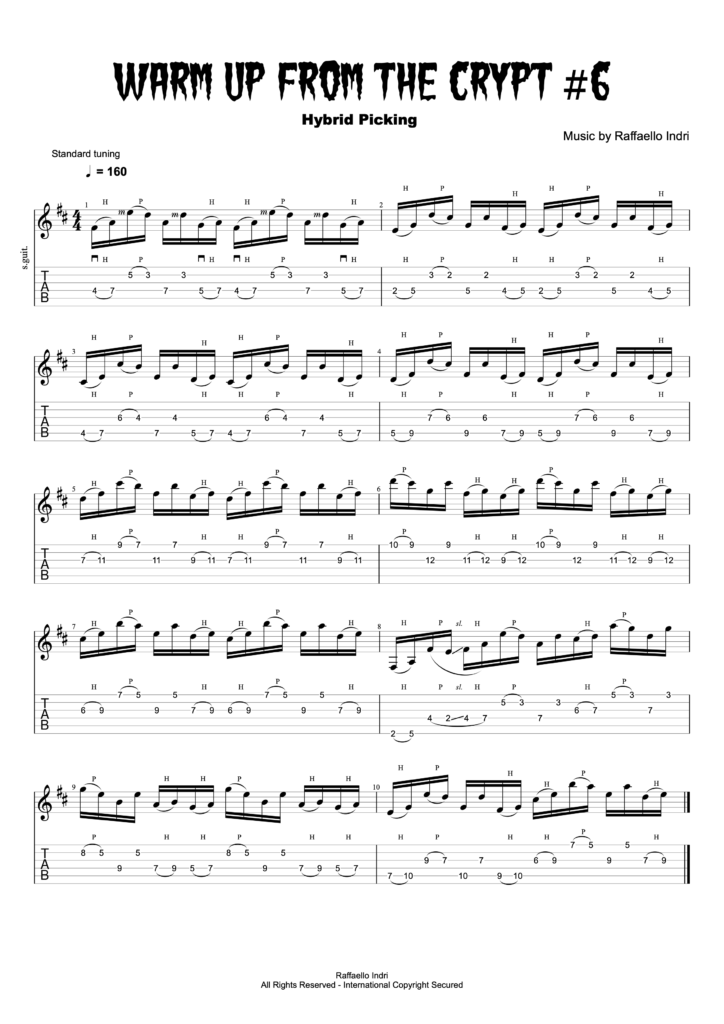
ENG
“It’s been several years now that, in modern guitar playing, alongside the simple use of the pick, the use of the right hand fingers to ‘pluck’ the strings has become increasingly important. This is not only for conventional arpeggios but also to generate more intricate melodic phrases. In the specific case, the technique of hybrid picking involves holding the pick with the thumb and index finger while integrating the use of the middle finger to pluck the strings. This significantly facilitates string jumps without exerting much effort on the wrist, which remains almost completely still.
In this case as well, the chosen sound for the exercise approaches the neoclassical world, which is dear to me. The technique at play has illustrious representatives in the world of country music, but the artist who has always fascinated me for quality and originality in phrasing is undoubtedly Brett Garsed. In his personal approach, he involves not only the middle finger but all the fingers of the right hand, including the pinky.
The recommended listening for this week is the album ‘Quid Pro Quo’ from 1992, together with guitarist Tj. Helmerich.”

Cari coraggiosi chitarristi, ecco il nuovo warmuppino settimanale:
WARM UP FROM THE CRYPT #5 – String skipping on triads
Tra le mie tecniche preferite, sicuramente rientra lo string-skipping.
In questo caso, ho preso diverse diteggiature relative alle triadi maggiori, minori e diminuite, a confezionare un esercizietto che strizza l’orecchio alle sonorità neoclassiche a me care.
Il warm up, al solito, è concepito in loop con un approccio “circolare”, ovvero inizia nelle prime posizioni, per procedere lungo la tastiera ad allenare diteggiature late e strette, per ritornare, quindi, al punto di partenza.
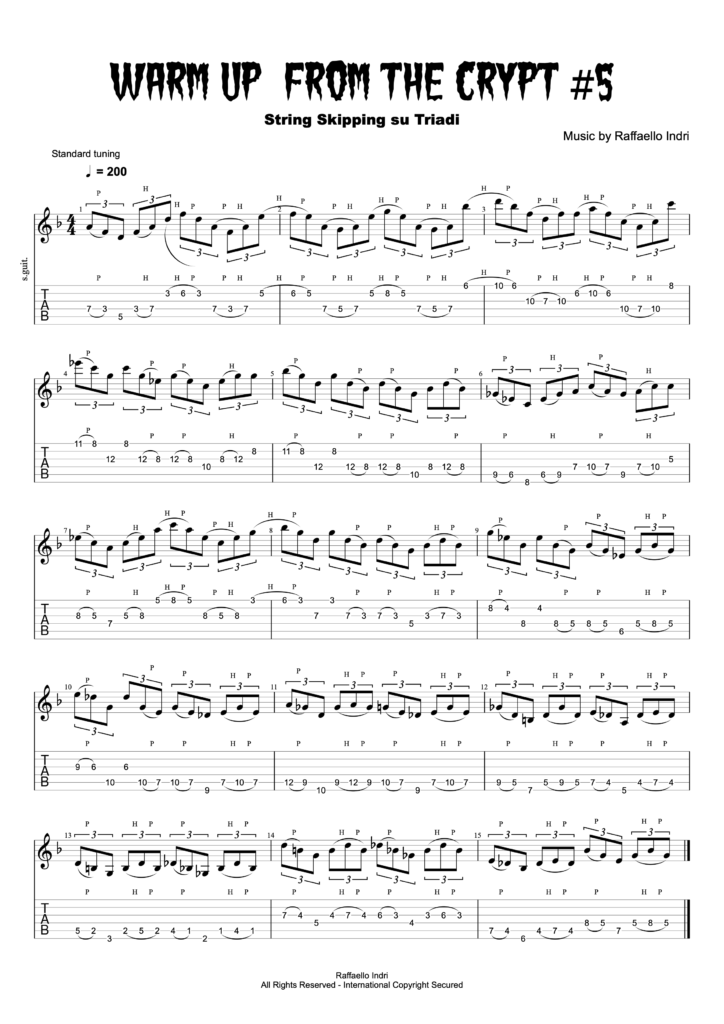
Il grande vantaggio che sottintende questo approccio rispetto allo sweep-picking è che non si è vincolati ad eseguire le triadi in un’ unica direzione melodica ascendente o discendente, ma possiamo prevedere diverse direzioni e sviluppi ritmici a condire in maniera interessante le nostre improvvisazioni, non solo neoclassiche, ma in qualsiasi contesto in cui vogliamo usare le triadi in senso melodico.
Diversi sono i chitarristi che usano lo string-skipping ma, al solito, ne citerei uno su tutti: il grande Paul Gilbert. Chitarrista, con una notevole carriera solista, ha militato nei Mr. Big e nei Racer X. Di questi ultimi consiglierei “Superheroes” come disco da ascolto obbligato 🙂
ENG
Among my favorite techniques, string-skipping is definitely one that stands out.
In this case, I’ve chosen various fingerings related to major, minor, and diminished triads to create a little exercise that nods to the neoclassical sounds dear to me.
The warm-up, as usual, is designed in a loop with a “circular” approach, starting in the initial positions, progressing along the keyboard to train both wide and narrow fingerings, and then returning to the starting point.
The significant advantage underlying this approach compared to sweep-picking is that it doesn’t bind you to execute the triads in a single ascending or descending melodic direction.
Instead, you can anticipate various directions and rhythmic developments to add interesting flavors to your improvisations, not only in neoclassical contexts but in any situation where you want to use triads melodically.
Several guitarists use string-skipping, but as usual, I would mention one in particular: the great Paul Gilbert. A guitarist with a remarkable solo career, he was part of both Mr. Big and Racer X. I would recommend “Superheroes” by the latter as a must-listen album 🙂
Raffaello Indri - International Copyright Secured